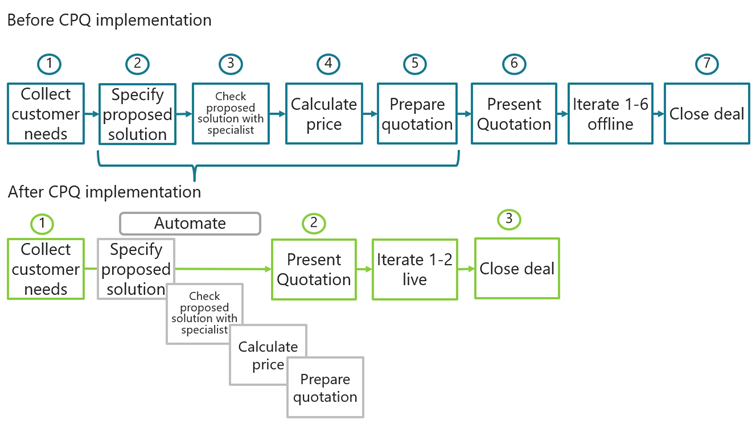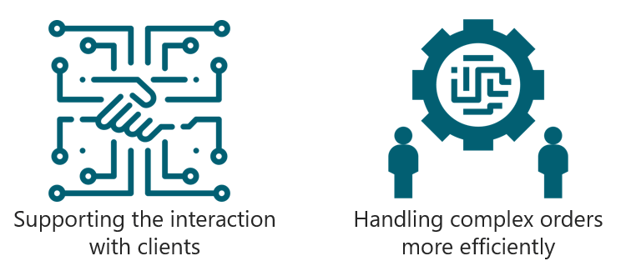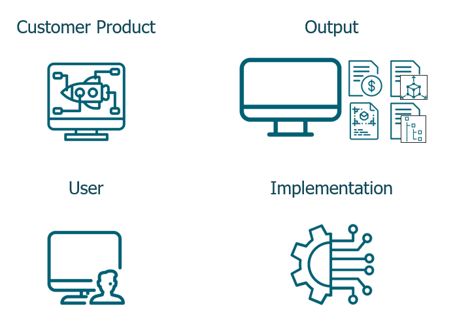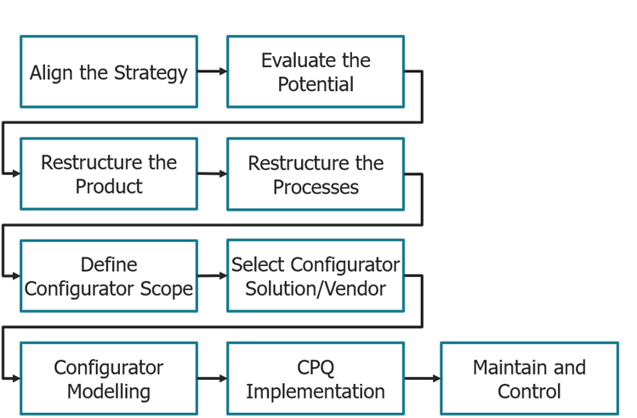Using CPQ Solutions and Online Product Configurators to Support your Sales Team
In today’s digital age, even the sales of the most complex and expensive products are moving online. Modern sales tools can gather customer and application needs and suggest customized solutions either through direct channels like e-commerce or by supporting sales teams and partners. These sales tools, known as CPQ solutions or Product Configurators, improve sales efficiency, increase the share of satisfied customers and reduce lead times to increase sales and profitability. By structuring the knowledge that today resides in the heads of your most experienced sales teams in a tool – you are not merely saving manhours, you are also creating customer value and scalability of the sales function.
In this blog post, I will discuss how to successfully prepare for and roll out a CPQ solution in your company.
Let me start with a true story about a company that sells equipment for the transportation industry. This company had a relatively poor configurator built in their ERP system, allowing only simple relation-based rules. However, since the tool was difficult to set up and maintain, the company had to simplify and reduce the number of configurable combinations. Unfortunately, combinations that were both technically and economically feasible were impossible to configure in the tool. One of the sales reps had a long history in the company and knew the products and technology well. He refused to use this tool because it limited what he could sell. Instead, he used his knowledge, making hand-written order sheets that he faxed to order reception. Since he was by far the number one sales rep in the company, nobody challenged him. Until one day, someone analyzed the profitability of orders. When measured on profits, this sales rep was no longer number one. He was well below average. Even though he knew the products well and didn't sell impossible combinations, he could not foresee the degree of customization, amount of additional order engineering, level of special low-volume buys, and added warranty costs incurred by his maverick orders.
What is CPQ or Online Product Configurator, and Why do you need it?
Configure, Price, Quote (CPQ) is software used in both business-to-business (B2B) and business-to-consumer (B2C) industries to support the sales of complex and configurable products. It is especially beneficial when deployed for products with high variability and when customers must be guided to find the best solution for their needs. It compiles the price and presents a quotation for the selection determined in guided selling.
A CPQ solution consists of three different engines. There is a configuration engine that executes the rules that are defined for how and what can be combined into sellable products. The pricing engine uses pricing algorithms to calculate the price for a product configuration, and there is a quotation engine that creates a presentation and description of the configuration.
With a CPQ solution, the sales-to-delivery process can be automated with many fewer manual interventions, as shown in the illustration below. This automation is where many of the benefits of a CPQ system are realized by a company.

Why do you need a CPQ Solution?
Of course, the answer varies from company to company, but the ultimate reason for implementing a CPQ solution is to improve profitability and sales in your company. This improvement is made by improving the quality of all steps in the sales-to-delivery process. Customer satisfaction is increased with reduced lead times in both quotation creation and product delivery. Sounds too good to be true – this is realized through:
- Automation of simple, less complex orders or portions of orders
- Improved integration of manufacturing and supply
- Repeatability of orders and configurations
- Clear distinction between Configure To Order (CTO) and Engineer To Order (ETO) in the sales process

Research and investigations show that companies that have successfully implemented a CPQ solution realize higher turnover, grow faster, and have greater profitability than their competitors.
How a CPQ Solution Reduces Sales Complexity
The benefits and value generated by a CPQ solution are to reduce cost of complexity in sales. To enable this, the product must be designed as part of a modular system to allow configurability.
Cost of complexity in sales is generated by:
- a large and complex product range
- overlapping products with inconsistent pricing
- lack of knowledge and experience of the complete assortment
- manual or semi-manual input of the customer specifications
- illustrations and drawings that are critical to understanding the proposed solution.
I could add more to this list, but it depends on your current situation and challenges. It is essential to understand your starting point and the ambition level to succeed with a CPQ implementation.
Why Modular Systems and CPQ Solutions are a Perfect Match
Modular Systems, developed from customer needs, enables configuration of products adapted to what the specific customer cares about. And what the customer cares about, is typically what the customer is willing to pay for.
As an example, assume that we are developing a residential vacuum cleaner. If we understand that some customers are especially interested in sustainability – we can use that knowledge to create option packages that can be presented in the online product configurator. By suggesting solutions that are relevant for the individual customer, sale is improved.
By surrounding the modules that are related to creating this option package with standardized interfaces, the possibility to configure this product is created without increasing product complexity.
How to Succeed with your CPQ Solution Implementation
What does it then take to succeed? Implementing a CPQ solution is a project that will cut across all functions of your company. It is vital to secure alignment, understanding, and agreement to the direction and ambition of the project. It is beneficial to perform a pre-study that defines the CPQ scope (both short-term and long-term), assess the improvement potential, and set the targets and strategy for a successful implementation. With this alignment, agreed-on targets and strategic direction, it will be much easier for you to get the right competence involved in the execution.
It is crucial to align your CPQ implementation program and strategy with your Modular System Strategy to assure success. This alignment will maximize the value of investing in your CPQ solution.
The CPQ implementation must not be limited to an IT transformation. It is crucial to align your CPQ implementation with your Modular System Strategy, to ensure a configurable product. If the product is designed as part of a modular system, and the variants depend on well-defined market needs, the product offering will have the flexibility required by the customers. This will keep complexity under control, without compromising sales.
The modular system should be more than a technical framework. The true benefits of modularity in the sales process will arise when the module system is the foundation of development, manufacturing and sales itself.
When setting the goals for your CPQ implementation, you need to consider which aspects of sales and delivery complexity you want to reduce and, in some cases, eliminate. Identify which parts of the process to automate and define what output you require from your CPQ solutions. Suppose you, for example, need 3D illustrations as part of the output. In that case, it is essential to couple your Modular System with the design of your configurator, simplifying the drawing generation of your configuration.
3 Success Criteria for Preparing and Planning your CPQ Implementation
There are, of course, many aspects to be considered when setting up for success. But these three are the fundamental hard factors to consider when you are preparing and planning:
- The products that you will configure using the CPQ solution need to be based on a modular product architecture designed for configuration. With this foundation, it becomes much easier to create the configuration rules that the configuration engine will execute.
- Explore your company's overall IT infrastructure, decide what integrations you want to do, and investigate/confirm that these integrations are feasible.
- Select a CPQ solution that supports your targets and the long-term CPQ scope (products, users, integrations, and output).

In addition to these hard factors, you need to consider the soft factors important to set up the organization for change. This consideration should be of both the way of working and in how to support the customers. It is also about how the CPQ solution and its system integrations will support the users and receivers of the result to process orders in a new, more efficient way (likely different from what it was before).
The fiercest opponents to implement a changed way of working may well be your most highly valued sales reps. Here you must make a tough decision. Do you take the fast and straight road or the long and windy road?
- Either you force conformity to the one new way of selling
- Or you allow senior sales reps to deviate, continuing with their preferred style. You start measuring them on profitability, not on sales revenue and slowly convert them to the new way of selling.
The second option is undesirable but may help people realize the benefits of a new way of working.
Parts of a Successful CPQ Implementation Project
Following the steps below will increase your chances of success when you set up your CPQ project. The steps are shown as a sequence, but there will be iterations between steps. Some steps can be started in parallel, but you typically do not finish an additional step until the one before is completed.

Align the Strategy – Secure stakeholder agreement on target ambitions and formalize CPQ implementation as a cross-functional business development project.
Evaluate the Potential – Uncover and understand the potential in your company as the foundation for defining KPIs with associated targets.
Restructure the Product – Evaluate how configurable your product(s) are. If necessary, improve the product structure to simplify the definition of configuration rules. The product should be as modular and configurable as possible.
Restructure the Process – Review the sales to delivery process in light of what you aim to achieve with the CPQ implementation (process automation, integrations, etc.).
Define the Configurator Scope – Which products will you include in the configurator? Who will use it? What integrations are necessary/optional, and what output do you need? Here you should aim for the long-term ambition to secure a CPQ selection that will serve you well for many years.

Select CPQ Solution/Vendor – Use the scope definition as the foundation for CPQ selection. Define the critical parameters in selecting support levels from the vendor(s) and any other service providers you might need that complement your competence in the project execution and business transformation.
Configuration Modelling – Build the configuration rules and configurator user interface. Define the associated pricing principles, quotation output principles, and quotation output details.
CPQ Implementation – Execute the IT implementation, roll out the functionality to the users, activate the training, and the other change management parts of the project.
Maintain and Control – Upon successful rollout of the solution, you must continue to maintain the content in the CPQ solution. Keep it in sync with product updates, pricing updates, and other improvements that users, clients, and administrators identify. You also need to monitor and, if necessary, adjust the user behavior and adherence to the new way of working.
Selling Configurable Products in the Digital Age
The competitive game is shifting fast:
- from selling to advising,
- from offering products that fulfill sales quotas to proposing solutions that help customers improve their profitability,
- from closing the deal to providing authentic, long-term customer satisfaction.
Implementing a CPQ solution based on a modular system is an excellent start to facilitate this change in your company. With a product line designed for configuration, you will set up your company for improved profitability and reduced complexity within the product line, operations, and sales, realizing many more satisfied customers.
Still not convinced? SalesForce research supports my claims above and shows that high-performing sales teams are 2.3 times more likely than underperforming teams to use guided selling. I believe you want to secure a firm position on the high-performing side.
From my experience, one of the critical steps is understanding what type of configurator you need, depending on the solution you are configuring. We have consolidated a guide to finding the type of configurator that you need.
Want to know more?
Please contact us if you'd like to discuss the topic covered or have a sounding board in general around Modularity and Product Configuration.
 Cristian Franzén
Cristian Franzén



